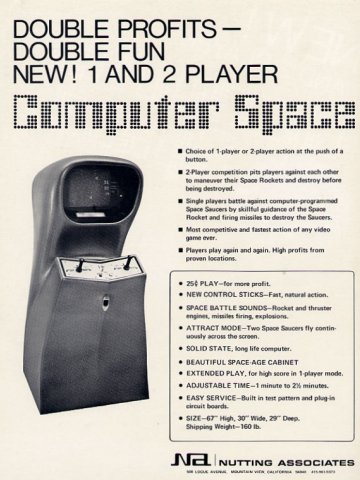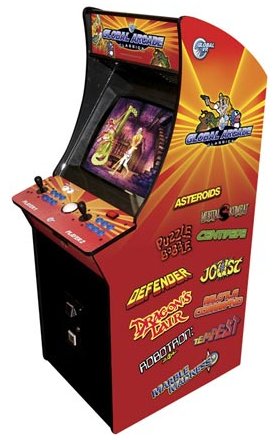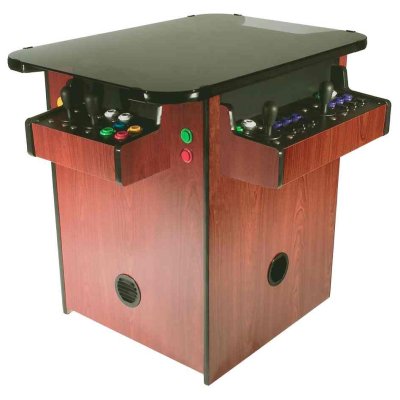| Author: | |
| Website: | |
| Page title: | |
| URL: | |
| Published: | |
| Last revised: | |
| Accessed: |
An arcade game is a coin-operated entertainment machine, typically found in amusement arcades, pubs, clubs, and other public venues where people may be looking for some form of diversion (while they wait for a bus or train, for example). Arcade games come in a variety of shapes and sizes, and include pinball machines and the kind of game where you have to retrieve a rather tacky-looking prize from the bottom of a glass cabinet by operating a miniature crane with a mechanical claw. The kind of arcade game we are interested in, however, is the arcade video game.
The design of such games owes something to the older, non-computerised games that have been around since before the beginning of the twentieth century, in that the cabinets that house them are usually ornately decorated. The games themselves typically have very short levels which become progressively more difficult, and easy to use controls. Racing games and flight games usually have a relatively gentle learning curve, unlike the racing and flight simulators which they are designed to resemble. Lighting in arcades that specialise in video games is typically subdued to inhibit glare on the screen.

A Cinamatronics version of Space Wars (circa 1977)
The world's first coin-operated video game was installed in a student union facility at Stanford University by students in 1971, and featured a game called The Galaxy Game, loosely based on the computer game Spacewar! developed at MIT during the early 1960s on a DEC PDP-1 minicomputer. Later during the same year, Nolan Bushnell and Ted Dabney developed another coin-operated version of Spacewar! called Computer Space, which was bought by a company called Nutting Associates. Nutting produced 1,500 units. The game was the first commercial, mass-produced video game.
Bushnell and Dabney went on to found Atari, and released a arcade video game called PONG (based on table tennis) in 1972. The emergence of Atari essentially signalled the birth of the coin-operated video game industry. Unfortunately for Atari, competitors quickly emerged to produce both PONG clones and other video arcade games.

Computer Space advertisement (Nutting Associates)
Early coin-operated arcade video games often used custom-built microprocessors, together with state-of-the-art sound and graphics cards. More recent arcade game hardware is usually a modified version of the technology used in popular games consoles, or consists of high-end PC components.
In some cases, the game controls involve a more fully-immersive environment than is available for game consoles or personal computers, including fully enclosed cabinets that reproduce the cockpit of an aircraft or racing car, and force feedback controls. The design of the cabinet itself can vary considerably, depending on the type of game it is designed to house. The elements that are commonly included in an arcade video game cabinet are listed below.

A typical arcade video game cabinet
The format of the cabinet itself can vary considerably, although upright cabinets are the most common type. They are usually constructed from wood and metal and stand approximately two metres in height, with the monitor mounted within the cabinet at eye-level, and the controls set perpendicular to the monitor and below it at about waist height. The marquee is usually above the monitor, and may overhang it. The controls provided will depend on the nature of the game itself, but may include joysticks and action buttons. For a car racing game, the controls may include a steering wheel and foot pedals.
Another format sometimes encountered is the cocktail or table style of cabinet. These are usually two-player games, and take the shape of low rectangular tables with a duplicate set of controls at each end and a horizontally mounted display in the centre which can reverse its vertical orientation depending on which player's turn it is to play. This type of cabinet was popular during the 1980s, and was often found in bars (the design was relatively unobtrusive, and included a tempered glass top that could be used to set drinks down on).
Various kinds of sit-down cabinets are used to house flight simulator or car racing type games, and often incorporate specialised game controls such as joysticks, steering wheels and foot pedals. The visible surfaces of the cabinet usually feature brightly coloured and artwork that represents some aspect of the featured game.

A cocktail table style arcade game
The first game to use a microprocessor (as opposed to discrete, highly specialised electronic components) was Gun Fight, a reincarnation of a game originally first seen in Japan, released by Midway Manufacturing for the US market in 1975. Game program code for microprocessor-based games hardware was often incorporated in ROM chips mounted directly on the system mainboard.
1976 saw Atari release the game Night Driver, believed to be the earliest example of a first-person car racing arcade game. The golden age of arcade video games is considered by some to have begun in 1978 with the release of the hugely popular Space Invaders by Taito. Namco released Galaxian (loosely based on Spacewars!) in 1975, and followed this in 1980 with Pac-Man, its biggest-selling game of all time.
Although the quality of the sound and graphics offered by these games was much improved, it was still relatively basic. The appeal of the games was essentially down to their game play, which accounts for the fact that many of the games of this era continue to be popular today, despite the enormous advances in gaming technology. Video arcades proliferated in the late 1970s and early 1980s, becoming so popular with adolescents that some parents voiced concerns that an obsession with playing arcade video games would lead to truancy.

Midway Manufacturing flyer featuring Pac-Man (circa 1980)
In 1980, the Data East Corporation (DECO) released the DECO Cassette System, a standardised arcade platform that could accommodate many different games. Other hardware technologies also began to emerge that separated the system hardware from the game itself, much in the same way that home game consoles could accommodate different cartridge-based games.
This was obviously of benefit to arcade proprietors, who could switch between different games by replacing just the game itself rather than the entire cabinet or its hardware. It also meant that manufacturers could concentrate on producing the relatively low-cost games themselves, rather than the far more expensive electronic hardware required to run them.

A scan from a DECO Cassette System brochure
There were a number of notable events during the 1980s. The release of Donkey Kong in 1981 popularised the platform game genre, and also introduced the Mario character (known at the time simply as Jumpman), as well as being more dependent on skill and timing than on simply shooting as fast as possible.
In 1983, the game Dragon's Lair from Cinematronics became the first to utilise laser disc technology to deliver high-quality animation. Arcade machines used 16-bit processors for the first time in 1984, allowing the use of more detailed and faster graphics. In 1985, Super Mario Brothers made the transition from the Nintendo Entertainment System to the arcade platform. Shadowland from Namco, released in 1987, was the first arcade game to feature 16-bit graphics, and NARC from Williams became the first to use 32-bit graphics in 1988.

Namco's Donkey Kong Arcade Video Game
By the early 1990s, arcade video games had begun to decline in popularity, partly due to the availability of home games consoles and the emergence of PC and online gaming. There was a brief resurgence in the fortunes of the arcade gaming industry with the appearance of games such as Street Fighter II released by Capcom in 1991, Mortal Kombat and Mortal Kombat II published by Midway and released in 1992 and 1993 respectively.
The competition from home game consoles and PC gaming had an adverse effect on arcade revenues during the latter half of the 1990s, however, and many new game titles were released directly for the home console platform rather than as arcade versions. By the late 1990s many video game arcades had gone out of business.
The arcade video game survives to this day by virtue of highly specialised games that do not scale easily to a home game console or PC-based environment. One notable exception to the overall decline in popularity is the game Dance Dance Revolution, which was first released in 1998 by Konami and has remained popular for many years. Other arcade video games have incorporated innovative features to attract customers such as motorised seating and surround-sound systems.

The Dance Dance Revolution arcade game
Many of the games that first appeared in arcades have since been ported to the PC or console platforms through the use of emulators. An arcade emulator is a program that allows the user to play one or more arcade games in (more or less) their original format on a personal computer. One of the first such emulators was Sparcade created by David Spicer, the first version of which was released in 1995.
Another emulator, the Multiple Arcade Machine Emulator (MAME), was released in 1997 by Nicola Salmoria and has become the dominant force in arcade emulation. Other emulators have since appeared, and include Nintendo's Wii Virtual Console and Microsoft's Xbox Live Arcade.